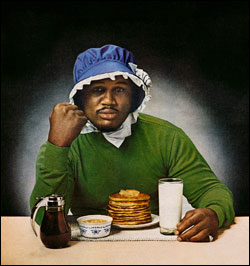African-American Photography Exhibit at the Thorne

KEENE, N.H., 9/30/10 - The Thorne-Sagendorph Art Gallery opens a photography exhibit that examines African-American history and culture while preparing to close an Art of Africa exhibit. “Double Exposure: African Americans Before and Behind the Camera” opens Saturday, October 23, and continues through Sunday, December 12, at the Thorne Gallery located on the Keene State College campus. “Art of Africa: Objects from the Collection of Warren Robbins,” which depicts how life and art come together in African culture, closes Sunday, October 31.
Two Keene State College art faculty members speak about each exhibit at an opening/closing reception, hosted by the Friends of the Thorne, on Friday, October 22, from 5:30 to 7:30 p.m. at the gallery. Stephen Lucey, who teaches art history at Keene State College, talks about the “Art of Africa” exhibit and Jonathan Gitelson, who teaches photography at KSC, speaks about the “Double Exposure” show.
Hank Willis Thomas, a photographer whose work is in “Double Exposure,” will speak and show slides of his photographs that deal with the language of advertising on Tuesday, October 26, at 7 p.m. in the Mabel Brown Room of the Young Student Center on the KSC campus. This lecture is sponsored by the Thorne Gallery and the KSC Office for Diversity and Multiculturalism.
“Double Exposure” explores the African-American cultural experience through photographic works from the 19th, 20th, and 21st centuries and includes photographs, albums, cased images, and contemporary artwork that incorporate vintage photographic imagery. Photographic techniques include daguerreotypes, tintypes, cartes de visites, traditional silver prints, Polaroids, digital prints, and photographs printed on linen, wood, and felt.
The exhibit, organized by The Amistad Center for Art & Culture, Inc. in Hartford, Connecticut, features the work of early known and unknown photographers, who pushed the boundaries of the medium to represent a black world of hope and dignity. “These collaborations were literally double exposures: photographer and subject creating a record of the moment possibly for family and friends, but also creating a body of work that would help to represent the totality of African-American life in the years after slavery,” states Dr. William Frank Mitchell, who wrote the wall text for this exhibit.
“Double Exposure” presents the history of African-American photography in thematic sections as opposed to a strict chronology. Major themes include the influence of historical and family photographs on contemporary art and the multiple uses of photographic appropriation; a technique that has been used since the 1970s to commemorate as well as to critique. The exhibition also highlights the importance of the portrait tradition in African-American photography from the earliest studio portraits from the 19th century to the mural size color and digital portraits made today. There are 50 works by contemporary Black photographers in the exhibit and approximately 45 photographs from the collection of The Amistad Center for Art & Culture, Inc. in Hartford, Connecticut, which organized the exhibit, sponsored by Aetna.
Also showing at the Thorne is the complementary “Art of Africa” exhibit, which presents sculpture, textiles, beaded clothing, and jewelry showing the creativity and diversity of artistic expression of nearly 30 cultures of sub- Saharan Africa. Accompanied by a video on African masks and dance, the exhibition illustrates the broader cultural context in which these art forms were created and used. “Art of Africa”, which continues through Sunday, October 31, is from the collection of the Robbins Center for Cross Cultural Communication and organized by International Arts & Artists, Washington, D.C. Educational materials for Art of Africa were funded in part by a grant from the National Endowment for the Arts.
The gallery’s new hours are Sunday to Wednesday, noon to 5 p.m.; Thursday and Friday, noon to 7 p.m.; and Saturday, noon to 8 p.m. It will be closed November 11 for Veterans Day and November 24-28 for Thanksgiving break. The exhibits, reception, and lecture are free and open to the public.
Located on Wyman Way on the Keene State campus, the gallery is accessible to people with disabilities. For information, call 603-358-2720 or visit www.keene.edu/tsag.





